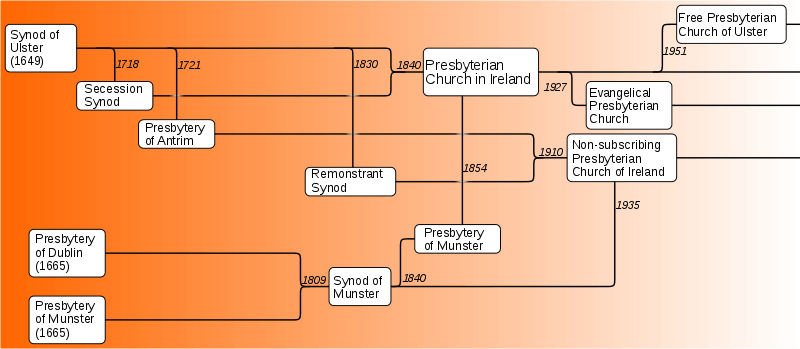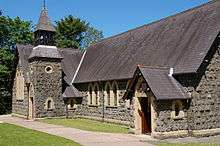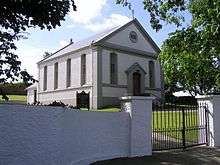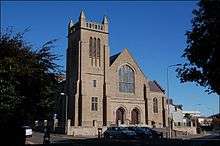Presbyterian Church in Ireland
The Presbyterian Church in Ireland (PCI; Irish: Eaglais Phreispitéireach in Éirinn; Ulster-Scots: Prisbytairin Kirk in Airlann)[2][3] is the largest Presbyterian denomination in Ireland, and the largest Protestant denomination in Northern Ireland. Like most Christian churches in Ireland, it is organised on an all-island basis, in both Northern Ireland and the Republic of Ireland. The church has approximately 225,000 members.
| Presbyterian Church in Ireland | |
|---|---|
 Modern logo of the Presbyterian Church in Ireland | |
| Classification | Protestant |
| Orientation | Calvinist |
| Polity | Presbyterian |
| Moderator | Rt Rev Dr David Bruce |
| Associations | World Communion of Reformed Churches |
| Region | Ireland |
| Founder | James I |
| Origin | 1610 |
| Branched from | Church of Scotland |
| Separations |
|
| Congregations | 536 |
| Members | 225,000[1] |
| Official website | www |
Membership
The Church has a membership of approximately 225,000 people in 536 congregations in 403 charges across both Northern Ireland and the Republic of Ireland. About 96% of the membership is in Northern Ireland. It is the second largest church in Northern Ireland, the first being the Roman Catholic Church.[note 1] In the Republic the church is the second largest Protestant denomination, after the Church of Ireland. All the congregations of the church are represented up to the General Assembly (the church's government).
History
Presbyterianism in Ireland dates from the time of the Plantation of Ulster in 1610. During the reign of James VI of Scotland a large number of Scottish Presbyterians emigrated to Ireland. The first move away from the Church of Scotland, of which the Presbyterians in Ireland were part, saw the creation of the Presbytery of Ulster in 1642 by chaplains of a Scottish Covenanter army which had arrived to protect the mostly Protestant British (Scottish and English) settlers in Ulster and to crush the Irish Rebellion of 1641 threatening these settlers. It succeeded in protecting the settlers, but failed abysmally to crush the rebellion. Under the more secure protection of Cromwell congregations multiplied and new presbyteries were formed. However, after the Restoration, nonconforming ministers were removed from parishes of the Established Church, but no matter the opinions of the king on religion, the Irish administration could not afford to alienate such a substantial Protestant population and Presbyterianism was allowed to continue in the country, with the stipends of ministers paid through the regium donum – literally 'the King's gift'.
William III rewarded Presbyterian support against James II (James VII of Scotland) with an increase in the regium donum. From the 1690s, Presbyterian congregations, now organised in the Synod of Ulster, enjoyed practical freedom of religion, confirmed by the Toleration Act of 1719. However, their members remained very conscious both of continuing legal disabilities under the penal laws and of economic hardship as many were tenant farmers and objected to the payment of tithes to support the Church of Ireland. Throughout the eighteenth century, many Presbyterians were involved in movements for reform, which culminated with their prominent involvement in the United Irishmen.[4]
The eighteenth century saw significant tensions within the Synod of Ulster, which was divided between the Old Lights and the New Lights. The Old Lights were conservative Calvinists who believed that ministers and ordinands should subscribe to the Westminster Confession of Faith. The New Lights were more liberal and were unhappy with the Westminster Confession and did not require ministers to subscribe to it. The New lights dominated the Synod of Ulster during the eighteenth century, allowing the more conservative Scottish Presbyterian dissenters, Seceders and Covenanters to establish a strong presence in Ulster.[5]
In the nineteenth century, a belief that some of those who did not subscribe to the Westminster Confession were in fact Arian provoked a new phase of the conflict.[6] This ended when seventeen ministers opposed to subscription seceded with their congregations to form the Remonstrant Synod. This led to the restoration of obligatory subscription to the Westminster Confession within the Synod of Ulster and facilitated union with the Seceders in 1840 to create the General Assembly of the Presbyterian Church in Ireland, whose first moderator was Dr Samuel Hanna. The united church was active in missionary activity both at home and abroad, particularly benefitting from the evangelical Ulster Revival of 1859.[7]

The Church today


The headquarters of the church are at Assembly Buildings, Fisherwick Place, Belfast, which were extensively renovated as part of a multimillion-pound project in 2010–2012. The Presbyterian Church in Ireland, a founding member of the World Alliance of Reformed Churches, has 540 congregations in 19 presbyteries across Ireland. The church's two nineteenth century theological colleges, Magee College (Londonderry) and Assembly's College (Belfast), merged in 1978 to form Union Theological College in Belfast.[8] Union offers post-graduate education to the denomination's candidates for the full-time ministry.
Until 2007 the church was connected to a credit union, Presbyterian Mutual, that collapsed with the savings of almost 10,000 members, almost all of whom were also members of the church.[9]
The PCI is involved in education, evangelism, social service and mission in a number of areas around the world:
Church and worship

Apart from the seats for worshippers, the inside of a Presbyterian church is dominated by four items of furniture.
- The Pulpit is the place from which sermons are preached. It generally occupies the central place in the church, reflecting the central place of the proclamation of the Word of God in the worship of the Church. .
- The Bible Stand holds the bible in a prominent place in the church. The bible is the source of all authority in the life of the church.
- The Communion Table, often placed directly in front of the pulpit. The associated chairs are occupied by the minister and elders during the service of Holy Communion.
- The Baptismal Font is used during baptisms, which is regarded as a sign of the covenant between God and the Church, welcoming the child into the community of the Church. Children are regarded as sharing the promise of salvation with adults in the church and have as much right to be baptised as adults. ('Infant Baptism' does not guarantee admission to Full Membership. Full Membership is only accepted on Profession of a personal Faith.)
Service
The Word of God is central in the Presbyterian Church, along with Prayer and Praise. The worship is a mix of prayers, hymns, psalms, paraphrases, Scripture readings and sermons. In recent years, psalms and paraphrases have been used less but are still an important part of worship. The order of service varies from church to church but it generally involves a hymn, followed by a prayer, followed by a children's address and a children's hymn. This is then followed by an expository sermon by the minister and another hymn, then another prayer and a closing hymn. Many Presbyterian churches mix Psalms and formal hymns with choruses, suitable for children, and many churches now have praise bands with a variety of instruments, as well as the traditional organ.
Logo and motto
The motto of the Presbyterian Church in Ireland is "Ardens sed Virens" – "burning but flourishing". It is usually seen alongside the Burning Bush, the church's symbol. A burning bush was included in the more modern logo (top).
According to the Bible, in Exodus 3:2, Moses heard the voice of God coming from a burning bush that was not consumed by fire. This occurred after he had to flee Egypt, and was when he was called to go and demand the release of the Israelites.
Social issues
The Presbyterian church has been active in commenting on a variety of social issues within and outside the denomination. In May 2006, the church's press officer announced that ministers could bless same-gender civil partnerships.[10] However, in June 2006, the General Assembly (GA) voted to ban its ministers from blessing same-gender relationships reversing the previous announcement.[11] In 2015, the church voiced its opposition to the legalisation of gay marriage.[12] On women's issues, the church ordains women as ministers.[13] On life issues, the denomination opposes abortion except for when the woman's life is in danger.[14]
Publications
- The Presbyterian Herald, is the official magazine of the Presbyterian Church in Ireland founded 1943
- The Missionary Herald of the Presbyterian Church in Ireland (1904 to 1946) incorporated into Presbyterian Herald
- The Witness, was a Presbyterian newspaper, published in Belfast (from 1874-1941)[15]
- Irish Presbyterian, (1853-1858 and 1895-1942) incorporated into The Presbyterian Herald
- The Banner of Ulster, was a twice weekly Presbyterian newspaper published first on 10 June 1842 by Rev William Gibson
- Young Men's Magazine, (1858-1859)
- The Presbyterian Penny Magazine, (1834-1837)
- The Orthodox Presbyterian, (1829-1840)
- The Covenanter, (1830-1843)
- The Bible Christian, (1830-1845)
- The Non-Subscriber, (1857-1863) re-founded as The Non-Subscribing Presbyterian in 1907
- The Orthodox Presbyterian, (1829-1840)
- The Presbyterian Churchman, (1877-1894)
Bodies to which the PCI is affiliated
- Irish Council of Churches
- Community of Protestant Churches in Europe (Leuenberg Church Fellowship)
- Conference of European Churches
- World Communion of Reformed Churches
See also
- Christianity in Ireland
- Presbyterianism
- Church of Scotland
- Religion in the United Kingdom
- Ulster-Scots
- History of Christianity in Ireland
- Other Presbyterian denominations in Ireland or Northern Ireland
Notes
- Confusion can arise from the fact that overall, the majority of the people of Northern Ireland are members of the various Protestant churches such as the Presbyterian Church, Church of Ireland, Methodist Church and several others. Therefore the Roman Catholic Church is smaller than the combined Protestant denominations in Northern Ireland.
References
- A Brief Guide to PCI Presbyterian Church in Ireland
- "maynoothcc.org".
- "Northern Ireland Statistics and Research Agency" (PDF). Archived from the original (PDF) on 17 February 2010. Retrieved 28 April 2012.
- S. J. Connolly ed., The Oxford Companion to Irish History (OUP, 1998), see also R. F. G. Holmes Our Irish Presbyterian Heritage (Belfast, 1985) and P. Brooke, Ulster Presbyterianism: the historical perspective (Dublin, 1987)
- Ian McBride,Scripture Politics: Ulster Presbyterians and Irish Radicalism in the Late Eighteenth Century, (Oxford, 1998)
- I. R. McBride, '"When Ulster Joined Ireland": Anti-Popery, Presbyterian Radicalism and Irish Republicanism in the 1790s', Past and Present 157(1997), pp.70–1
- D. W. Miller, 'Did Ulster Presbyterians have a devotional revolution?' in J. H Murphy (ed.), Evangelicals and Catholics in Nineteenth Century Ireland (Dublin, 2005) pp52-4.
- Presbyterian Church in Ireland Press Release, 2003 Presbyterian College Celebrates 150 Years Archived 19 November 2008 at the Wayback Machine. Retrieved on 8 March 2008.
- Church's PMS report submitted to working group, 7 October, Belfast Newsletter
- Crawley, William. "BBC - Will & Testament: Official: Irish Presbyterian Clergy Can Bless Gay Partners". Retrieved 29 May 2016.
- "Presbyterian church bans blessing of gay couples". The Irish Times. Retrieved 29 May 2016.
- "Presbyterian Church sticks to its position on gay marriage despite plea to think again - BelfastTelegraph.co.uk". BelfastTelegraph.co.uk. Retrieved 29 May 2016.
- Crawley, William. "BBC - Will & Testament: Will Presbyterians ever elect a female moderator?". Retrieved 29 May 2016.
- "Churches views vary on abortion | The Irish Catholic". www.irishcatholic.ie. Retrieved 29 May 2016.
- Library Presbyterian History Ireland.
Further reading
- Finlay Holmes The Presbyterian Church in Ireland: A Popular History. (Blackrock, Co. Dublin: The Columba Press, 2000) ISBN 1-85607-284-3
- Laurence Kirkpatrick Presbyterians in Ireland: An Illustrated History. (Holywood, Co. Down: Booklink, 2006) ISBN 0-9554097-1-3
- Ian McBride,Scripture Politics: Ulster Presbyterians and Irish Radicalism in the Late Eighteenth Century, (Oxford: Calrendon Press, 1998) ISBN 0-19-820642-9
External links
- Presbyterian Church in Ireland
- The Presbyterian Herald Online – Church Newspaper
- pciyac.org – Website of the PCI Board of Youth & Children's Ministry
- youth.ie
- – Mission in Ireland department online
- Presbyterian Historical Society of Ireland